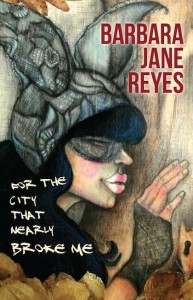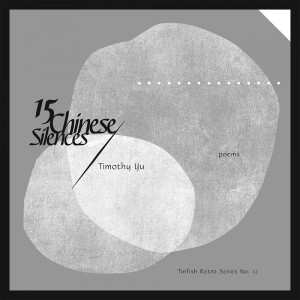For The City That Nearly Broke Me by Barbara Jane Reyes | Aztlan Libre Press 2012 | $13
In my California, we know how to party. We Black Panther Party. We 2PAC and Dre. We Dime a Day, we Dollar a Dance. We Fillmore jazz. We Summer of Love. We Barbary Coast. We I-Hotel. We Chinatown. We North Beach howl.
In my California, we no Baywatch babe. We East Los, we South Central LA. We Rodney King video. We campesino. We mighty Sacramento River. Rooted deep sequoia giants, we lovin’ the wind, we kissin’ the sky.
(from “My California” 34)

I met up with Barbara Jane Reyes at Shooting Star Cafe in Oakland Chinatown to chat about her new chapbook For The City That Nearly Broke Me. The project started with a writing prompt: write about a city that saved you, then write about a city that broke you. As Barbara began to think about what it would mean “to be broken by a city,” she decided to approach it by writing about places that “were the most emotionally complicated for me.” The chapbook hovers over and between Manila (“my birthplace but not necessarily my home”) and Oakland, where she has been living for the past decade but is not sure she can claim as her own.
I resonated with what Barbara had to say regarding the internal conflict inherent in claiming place and claiming home. Many immigrants and children of immigrants struggle with a similar tension; our birthplaces (or our parents’ birthplaces), with their histories of colonization, are now tourist destinations, and both the industry of tourism and the good intentions of our families make it difficult for us to “forge a connection” with these places. In Barbara’s case, her “attempts to go deeper are thwarted” by the gaze of the tourist as well as by her own family, who implies that there are things about Manila she might not be able to handle, that “there is only so much we want you to see.”
The title poem of the chapbook has 17 parts, #3 of which, “Junto al Pasig,” references a José Rizal poem and talks about the Pasig River. Barbara spoke about the Pasig as a river that gives its name to the Filipino people, but a river that is also environmentally dead. Many squatter communities now make their homes around this dead river. Barbara’s “Junto al Pasig” illustrates the sacred decay of the river with a juxtaposition of two “streams,” in a sense; one of “giardia,” “DDT” and “blooming cholera” and another of divine incantation and “divina aurora” (5).
In our conversation at Shooting Star, Barbara talked about returning to Manila to see her family in the outskirts of town, with non-flushing toilets and mosquitoes, but that her view of the city is also through the tinted window of an air-conditioned car, or through the lens of academia. Barbara told me that when she had exhausted that tinted view in her writing about Manila, she “created a persona to walk through the city.” This persona is the figure of Black Jesus, a religious idol that had been charred in a fire, but to which many people in Manila come to for miracles. For Barbara, this dark-skinned icon helps her walk through the city of skin-whitening lotion to the parts she cannot see.
Writing through the voice of Black Jesus helps Barbara make sense of her being in a place, whether or not she feels she can stake claim to it as her own. Black Jesus could very well walk the streets of Oakland too, and in the case of Oakland, with its very deep legacy of revolutionary activists and communities of color, gentrification and the hipster gentrifier stand alongside the tourist and the protective family member, making us wonder who can claim Oakland as home, and who has the right to.
Many of the poems in For The City That Nearly Broke Me are written after poems by other writers. Barbara constructs her poems with a gorgeous musicality; anaphora and litany appear strongly in many of the pieces. I asked Barbara about lineage and about these poetic devices. For Barbara, it’s not a contradiction that writers like Al Robles, Anne Waldman, Juan Felipe Herrera and Langston Hughes “are all simultaneously informing my work.” Anne Waldman’s epic “Fast Speaking Woman” has influenced her for the ways in which repetition is a performative practice. Barbara recognizes the same sense of repetition and anaphora in Juan Felipe Herrera’s work as enacting a “community practice”; Herrera’s poems are “meant to be sung by many voices simultaneously, which speaks of a city,” says Barbara. This sense of borrowing from other writers and other voices in her chapbook project feeds into this question of reclamation—using other voices may not help her “forge a connection” with the cities of Manila or Oakland, but it helps her grapple with how she can lay claim to multiple spaces.
The polyvocal quality of the chapbook lends itself well to performance, and Barbara realizes that these poems indeed “beg to be heard” in public spaces and beg to be sung on the streets, as she finds herself returning to the place from which she entered poetry—the spoken word. This made me think of Barbara’s long-standing presence in the Bay Area as a writer and teacher, and the ways her voice continues to resonate and be relevant to young folks. I said that I want to see this book in the hands of Oakland youth of color and young Pilipinas. In response, Barbara talked about reading from the chapbook at a charter school in Oakland and that there were “snaps all around.” The Oakland poems resonated with the youth there, and Barbara talked about the perhaps “cliché” phrase “another brother gone” (which she references in “West Oakland Invocation”), that is in fact not a cliché, but something that we constantly need to be reminded of when it comes to the realities of life for youth of color in Oakland, something that “we need to constantly be saying out loud.”
As a transplant from Manila and a transplant to Oakland, Barbara’s voices, borrowed and found, decolonize the streets and rise up through the stench and grit, building a sonic landscape rich with the textures of song.
I sing for refrigerators parked in front yards, for washing machines chillin’ on the sidewalk. I sing for tireless cars raised up on wooden blocks. I sing for salvage and sculpture. […]
I sing for the sugarpie lady, I sing for her curlers and slippers. I sing for the chainsmoking lady in second hand sneakers, who used to be homeless, and who now is dead.
I sing for the gunshots. I sing for the gunshots. I sing for the gunshots. I sing for the gunshots.
(from “West Oakland Serenade” 29 – 30)
Many thanks to Barbara Jane Reyes for the conversation.
* * *
15 Chinese Silences by Timothy Yu | Tinfish Press 2012 | $3
And then—don’t tell anyone—
I smile into my diet cola
and in the manner of the ancient Chinese
pick up my dried-out pen
and tattoo on the skin of my palm
a character that means
‘A journey of a thousand miles
is really, really long.’(from “Chinese Silence No. 10”)

“Enjoy the silence!” is Timothy Yu’s inscription to me in my copy of 15 Chinese Silences. And I do, as someone rather obsessed with (and who is a product of) cultural silences and silencing. But what I enjoy about this project even more is its parody, and the ways it makes absurd the poetic ethos of Billy Collins by outing his racism and his incurable Asian fetish.
As Yu states in the notes, this project was born in response to Billy Collins’ poem “Grave,” in which the speaker stands before the tombstones of his parents. He references the “one hundred kinds of silence / according to the Chinese belief” but then later in the poem confesses that the silences are something he “just made up.” A white poet inventing Chinese silence in order to get deep with his dead white parents? That’s crazy. Yu is attempting to write these 100 Chinese silences by parodying Collins’ poems, line by line.
The Chinese silences (or silenced Chinese-ness) that haunt and give false poignancy to Collins’ poems are upturned in Yu’s reconstruction. It’s like the moment in Yu’s “Chinese Silence No. 11” (after Collins’ “Drawing”): “I turn the picture upside down. / Now it looks Chinese, / burrowing silently earthward.” Yu flips Collins’ perspective by entering Collins’ poems silently, in the corner—”He doesn’t notice as I enter here, / pull up a barstool, / contort my spine like his, in silence” (from “Chinese Silence No. 3”). Yu enters the whiteness of the poem (mimicking Collins’ Chinese silence) and slowly takes up more and more space, more and more voice, until Collins’ whiteness becomes what is ghosted, and we open our ears to other sounds.
Yu exposes the ridiculousness of Collins’ aesthetic by creating a caricature out of him—an old white poet to match the old Chinese poet that Collins uses to add an ambiguous “weight” to his poesis. The culturally appropriative “Asian fetish” aesthetic in contemporary poetry by white men often goes unchecked, or is responded to by audiences with delicate sighs. The way poets like Collins commodify Asian cultural signifiers and emotional valences, like the concept of a “Chinese silence,” results in nothing more than empty “poetical” gestures: a line of artsy soy sauce containers white people can use to flavor their poet laureate poems.
In this project, Yu enters Collins’ poems as the Chinese silences Collins manufactures, and then flips the poems inside out. Yu gently mocks the orientalism of Collins’ attempts to adopt a “Chinese tone” and makes absurd the whole idea of “China as affect” in his work. Yu sits down with Collins and has silent conversations, gets inside his head, and exposes the ways Collins has embedded himself in a highly problematic construction of what China is in white poetics, and how whiteness imagines (and indeed, often creates) an aesthetic that it deems “Chinese.”
All morning we read side by side,
me with my commentary
and he shushing me into silence,
until the book is finished
and its pages lie discarded all around us;
then, I hear him speak.Is not each of these poems, he asks,
itself a form of Chinese silence?Actually, no, I reply, each is a testament
to the noise of being Asian in America.
To silence them would be to erase them
into blank pages for your own projections.Ah so, he says, shaking his bottle of White-Out
and poising the wet brush over the poem,
then spreading the pungent liquid over the page
until the words are silenced.(from “Chinese Silence No. 12, after Billy Collins, ‘Shoveling Snow with Buddha'”)
To read more from Timothy Yu’s “100 Chinese Silences” series, see Silences No. 16 and No. 37 in Lantern Review Issue 4.
4 thoughts on “Two Reviews: Barbara Jane Reyes’s FOR THE CITY THAT NEARLY BROKE ME and Timothy Yu’s 15 CHINESE SILENCES”